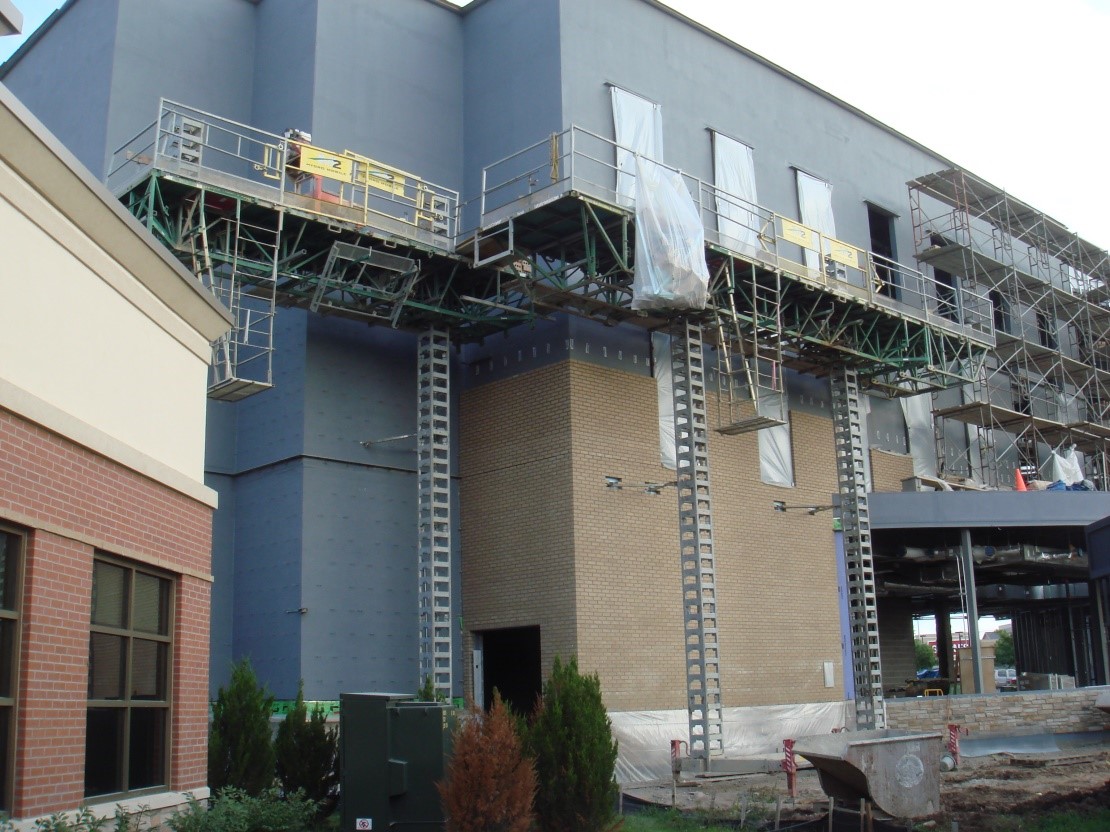Many contractors, including mason, sealant, waterproofing and restoration contractors, frequently use aerial work platforms to reach their work. Besides aerial work platforms such as boom lifts and scissors lifts, mast-climbing work platforms (see photo) are becoming more common due to their large working platforms and relatively quick assembly. CalOSHA describes a Mast-Climbing Work Platform (MCWP) as “a powered elevating work platform or platforms, supported on one or more vertical masts, for the purpose of positioning personnel, along with necessary tools and materials, to perform their work.”
When a mason chooses to use a mast-climbing work platform (MCWP), obviously he not only wants to create a safe work environment but he also wants to make sure that he is complying with the applicable CalOSHA safety standards. Admittedly, there appears to be some confusion regarding the classification of a MCWP. While U.S. federal OSHA includes the standards for aerial work platforms, including MCWPs, in the scaffold standards, they are treated separately from the normal scaffold equipment. In California, CalOSHA has an entirely separate section for aerial platforms and MCWPs and can be found beginning in § 3637 of Article 24, Group 4, Subchapter 7 of the General Industry Safety Orders. While MCWPs may be different from regular scaffolding, the hazards should be familiar to anyone working at heights; these hazards include:
• Falls from heights;
• Poor foundation;
• Lack of access;
• Platform overload;
• Falling Objects;
• Lack of Stability;
• Faulty erection and dismantling procedures.CalOSHA expects you to provide a guardrail system at all open sides and edges of platforms more than 7’-6” above the level below. The toprail shall be at 39 inches, plus or minus 3 inches. For MCWPs used by “glaziers, bricklayers and stonemasons, the inboard guardrail may be removed provided: (a) the inboard edge of the work platform is no more than 7 inches from the finish face of the building or structure on which work is being performed or (b) approved personal fall protection systems are used.” For other work activities, the platform edge can be no more than 12 inches from the building or structure wall unless approved personal fall protection systems are used.
There are also hazards that are specific to mast-climbing work platforms. Accidents and fatalities have occurred as a result of improper removal of structural ties that connect the mast to the building. These ties are crucial to the safe assembly and use of the platform since they provide the strength and stability to the mast. It must be noted that these ties are not your common scaffold ties where the removal of one will not likely bring the scaffold down but rather are the key component that keeps the platform and mast from collapsing. The MCWP tie is an engineered structural component that must be installed according to the manufacturer’s instruction to ensure safe use of the platform.
Another specific hazard is the overloading of the platform. MCWPs typically have a high load capacity when the load is properly placed on the platform. Care must be taken to precisely follow the manufacturer’s load diagram that is attached to the machine. Non-compliance with the loading diagram can easily result in collapse, particularly when loads are improperly placed on cantilevered platforms.
It is tempting to use a mast-climbing platform as an elevator for personnel and or material. This is specifically prohibited by CalOSHA in §3646(k). To clarify, a mason for example, can ride the platform up to the fourth floor to do his work but he cannot give the electrician a ride to the fourth floor. Additionally the mason cannot transport conduit and wire for the electrician to the fourth floor. However, the mason can transport his own brick and mortar to the fourth floor to accomplish his work. In other words, a MCWP is not a personnel hoist or material hoist but rather an elevating work platform for workers and their materials.
Access to the platform is normally at ground level although direct access to an upper building floor is permissible provided fall protection is provided where required by CalOSHA. Extension ladders should not be used for access to a mast-climbing platform since the ladder can be easily dislodged as the platform ascends. The built in ladder provided by the manufacturer should always be used. Depending on the manufacturer, it may be permissible to use the mast as access to the platform. Do not climb the mast if it hasn’t been purposely designed for access since it is very difficult, if not impossible, to get on a platform from the mast without the correct access components.
Do not use the mast or platform as an anchor for personal fall protection unless it is allowed by the manufacturer. It is always better to use the adjacent structure as the anchorage; make sure that the anchor is designed by a Qualified Person to hold the anticipated fall forces.
These are just some of the highlights describing the safe use of mast-climbing platforms. The American National Standards Institute, ANSI, has an excellent standard describing the requirements of the parties involved with mast-climbing platforms. If you are an owner, renter, seller, buyer, erector, user, operator, or maintainer of MCWPs, you should have this standard, read it, understand it, and comply with it. It is more comprehensive than the CalOSHA regulations, and will give you the minimum requirements that are necessary to create and work in a safe environment. (The ANSI standard, A92.9 can be purchased from the Scaffold and Access Industry Association at www.scaffold.org)









